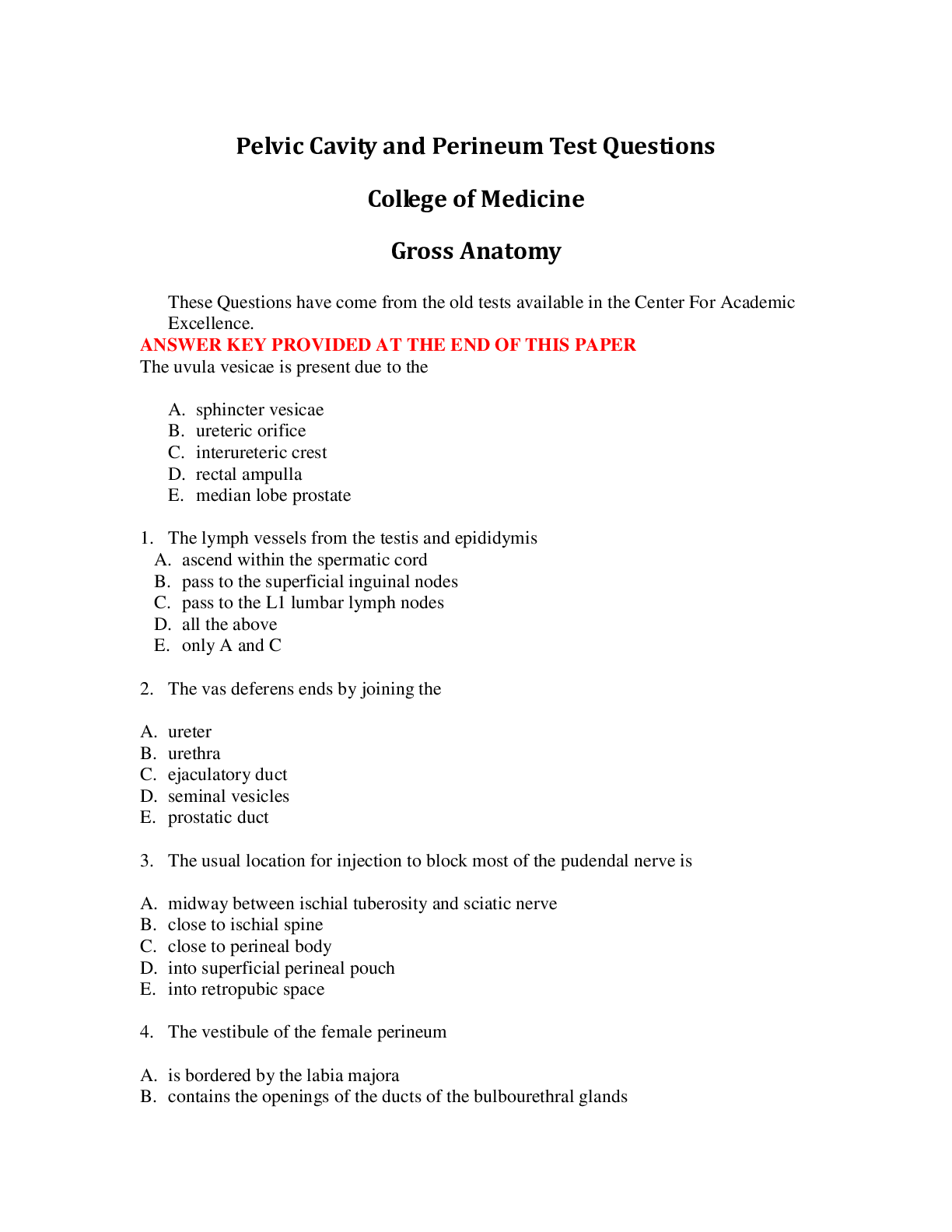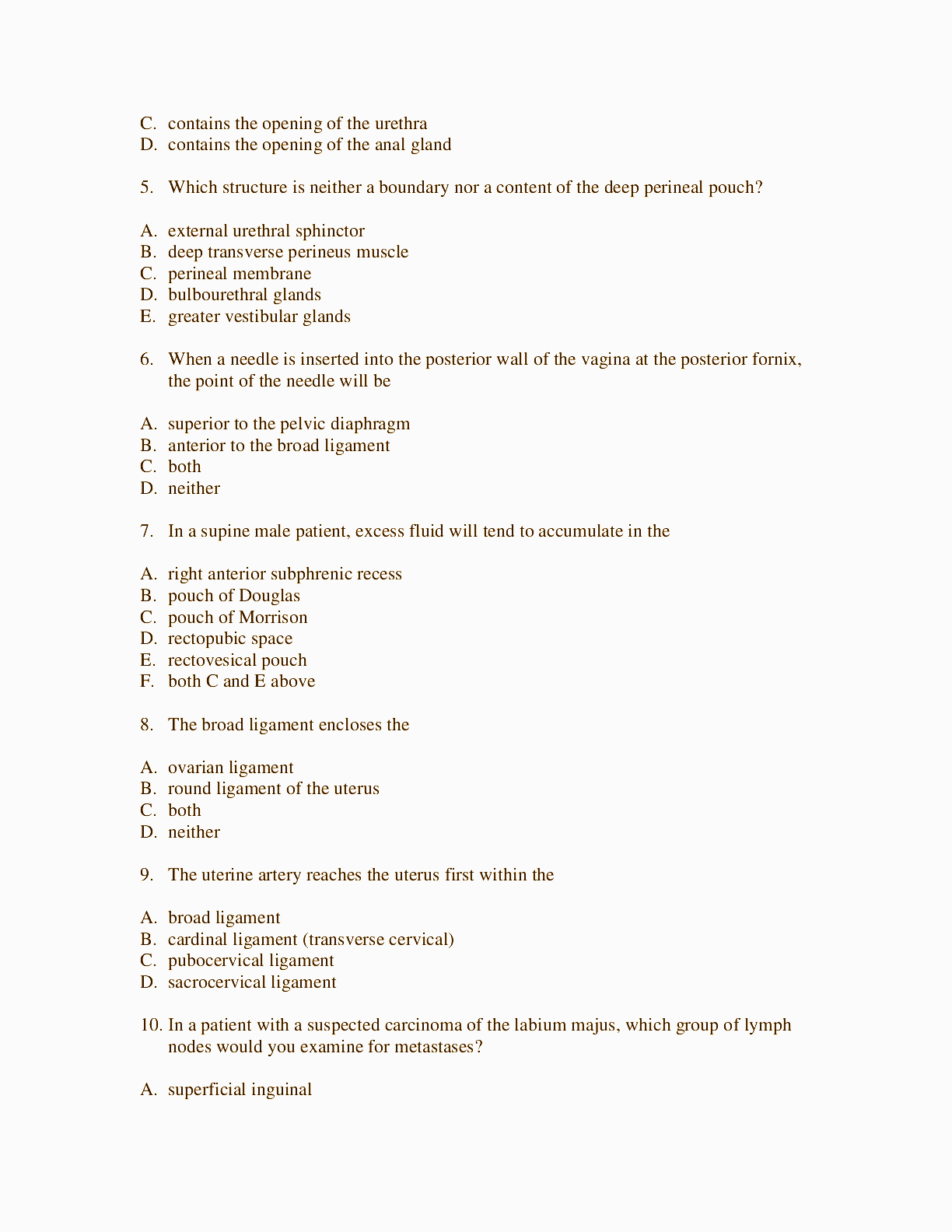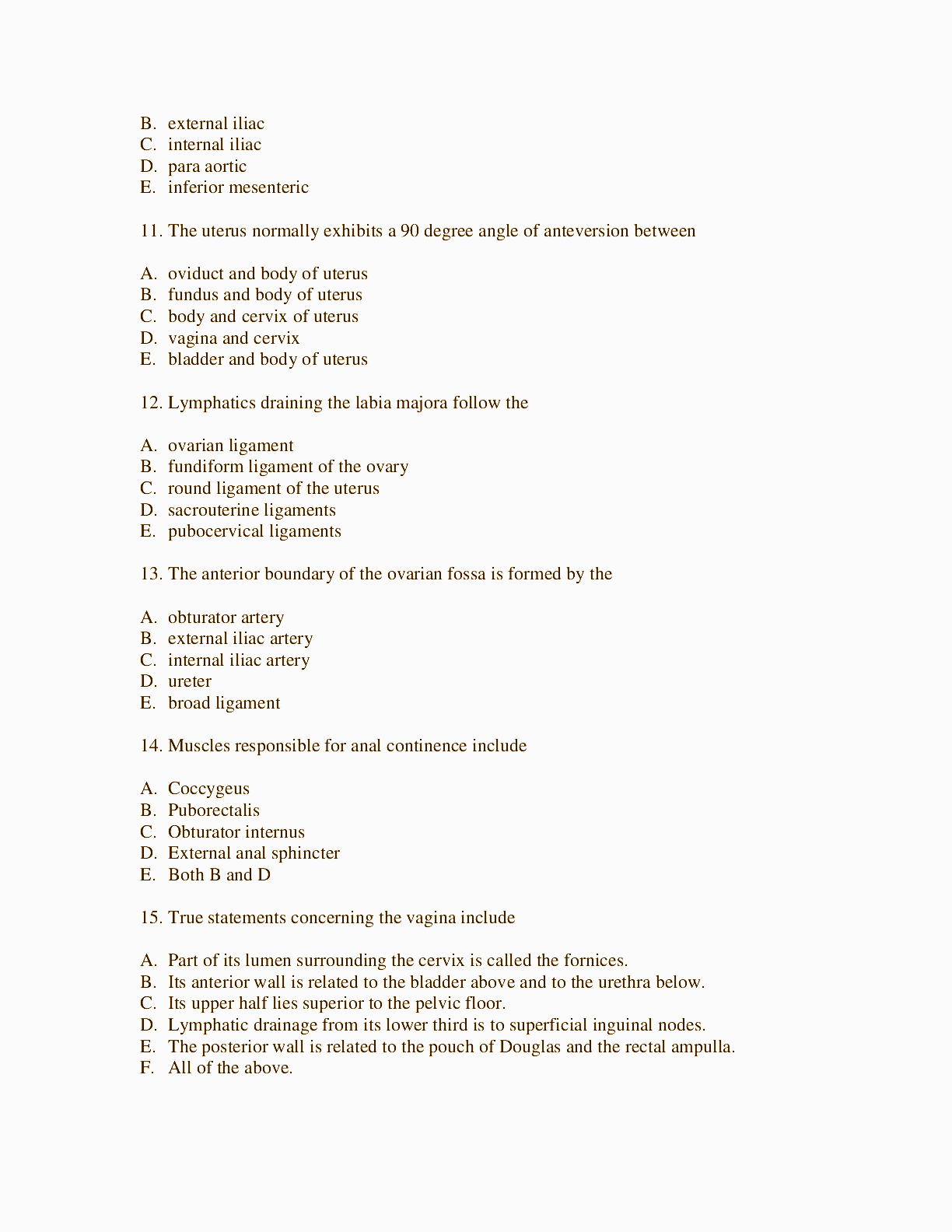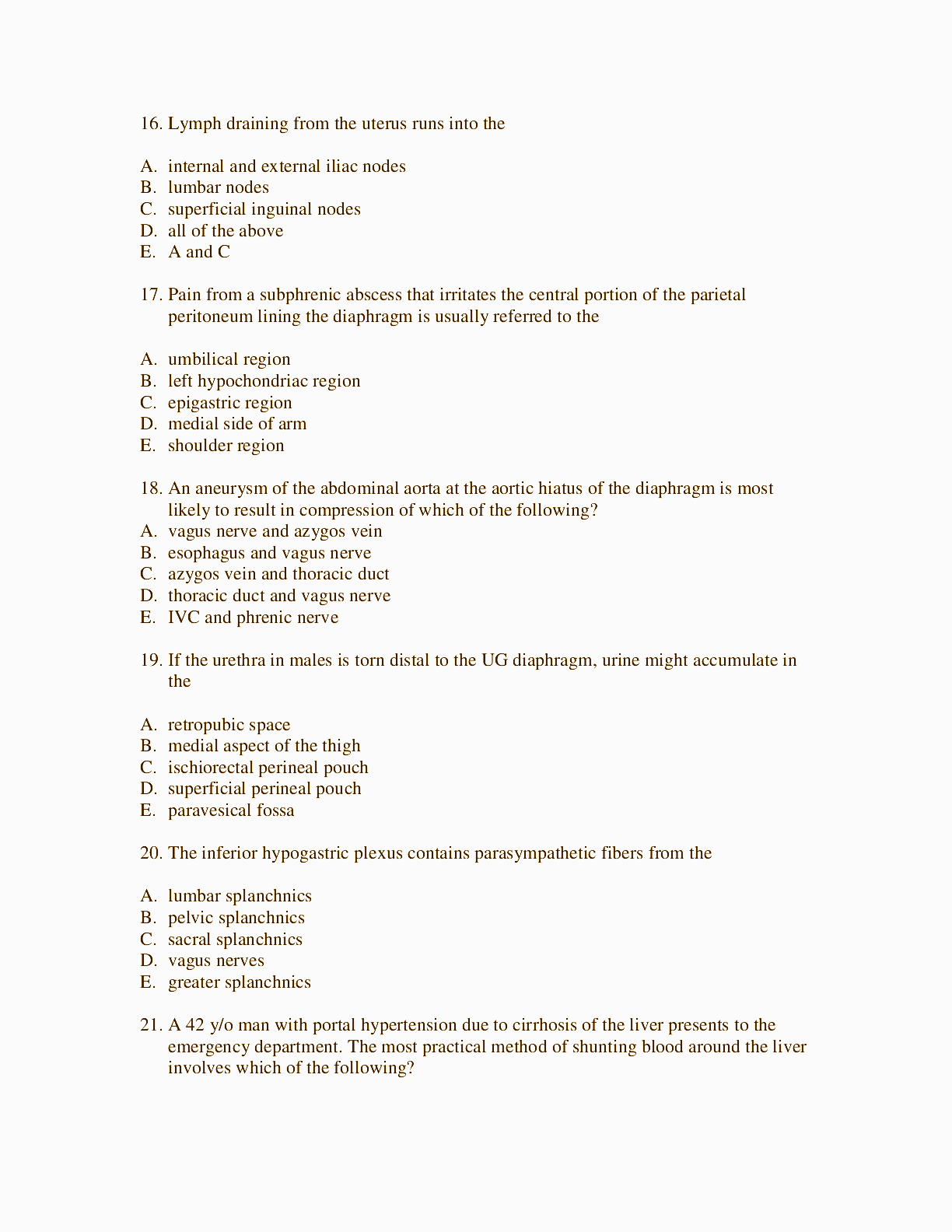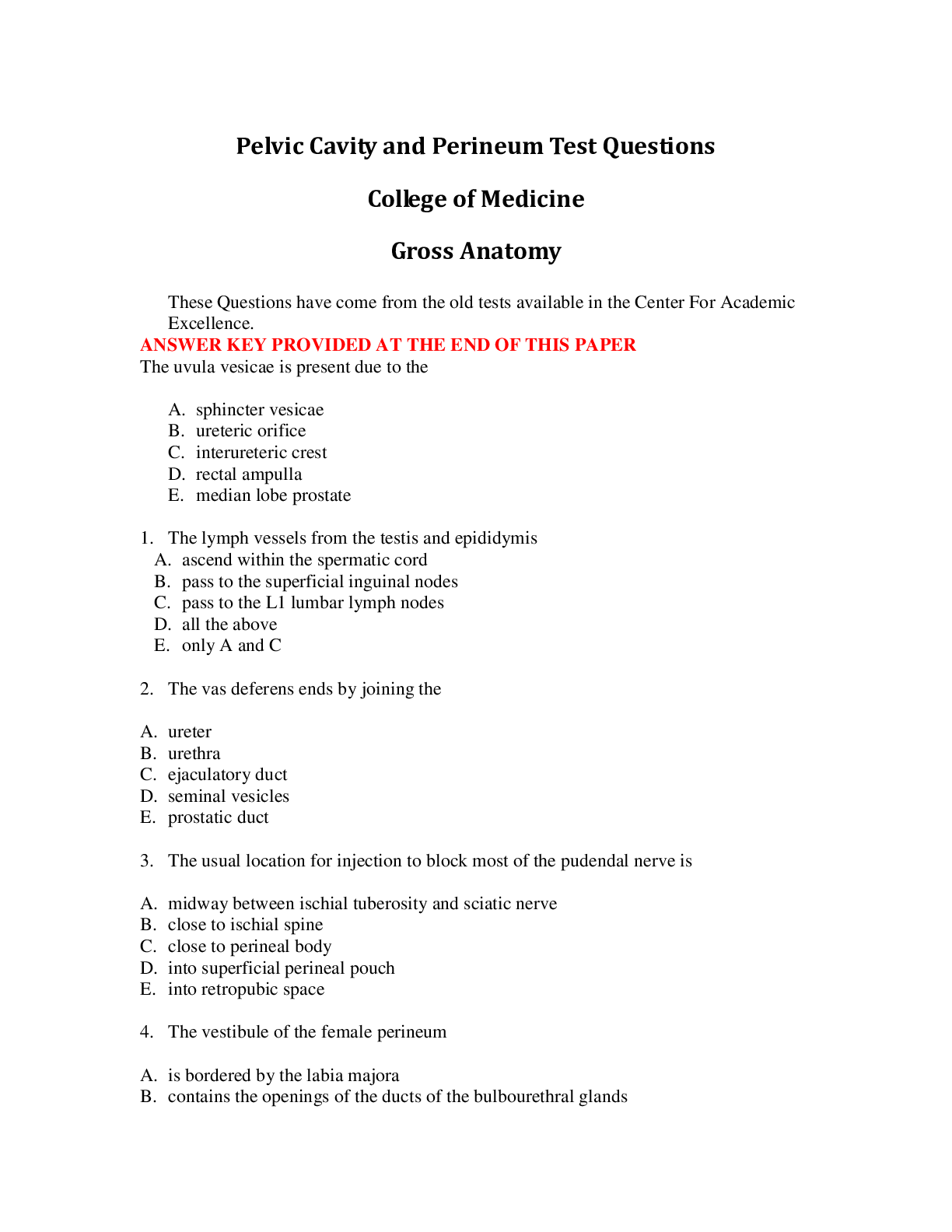These Questions have come from the old tests available in the Center For Academic
Excellence.
ANSWER KEY PROVIDED AT THE END OF THIS PAPER
The uvula vesicae is present due to the
A. sphincter vesicae
B. ureteric orifice
C. interuretericcrest
D. rectal ampulla
E. median lobe prostate
1. The lymph vessels from the testis and epididymis
A. ascend within the spermatic cord
B. pass to the superficial inguinal nodes
C. pass to the L1 lumbar lymph nodes
2.
D. all the above
E. only A and C
The vas deferens ends by joining the
A. ureter
B. urethra
C. ejaculatoryduct
D. seminal vesicles
E. prostaticduct
3. The usual location for injection to block most of the pudendal nerve is
A. midway between ischial tuberosity and sciatic nerve
B. close to ischial spine
C. close to perineal body
D. into superficial perineal pouch
E. into retropubic space
4. The vestibule of the female perineum
A. is bordered by the labia majora
B. contains the openings of the ducts of the bulbourethral glands
C. contains the opening of the urethra
D. contains the opening of the anal gland
5. Which structure is neither a boundary nor a content of the deep perineal pouch?
A. external urethral sphinctor
B. deep transverse perineus muscle
C. perinealmembrane
D. bulbourethral glands
E. greater vestibular glands
6. When a needle is inserted into the posterior wall of the vagina at the posterior fornix, the point of the needle will be
A. superior to the pelvic diaphragm
B. anterior to the broad ligament
C. both
D. neither
7. In a supine male patient, excess fluid will tend to accumulate in the
A. right anterior subphrenic recess
B. pouch of Douglas
C. pouch of Morrison
D. rectopubic space
E. rectovesical pouch
F. both C and E above
8. The broad ligament encloses the
A. ovarian ligament
B. round ligament of the uterus
C. both
D. neither
9. The uterine artery reaches the uterus first within the
A. broad ligament
B. cardinal ligament (transverse cervical)
C. pubocervical ligament
D. sacrocervical ligament
10. In a patient with a suspected carcinoma of the labium majus, which group of lymph nodes would you examine for metastases?
A. superficial inguinal
B. external iliac
C. internal iliac
D. para aortic
E. inferiormesenteric
11. The uterus normally exhibits a 90 degree angle of anteversion between
A. oviduct and body of uterus
B. fundus and body of uterus
C. body and cervix of uterus
D. vagina and cervix
E. bladder and body of uterus
12. Lymphatics draining the labia majora follow the
A. ovarian ligament
B. fundiform ligament of the ovary
C. round ligament of the uterus
D. sacrouterine ligaments
E. pubocervical ligaments
13. The anterior boundary of the ovarian fossa is formed by the
A. obturator artery
B. external iliac artery
C. internal iliac artery
D. ureter
E. broad ligament
14. Muscles responsible for anal continence include
A. Coccygeus
B. Puborectalis
C. Obturator internus
D. External anal sphincter
E. Both B and D
15. True statements concerning the vagina include
A. Part of its lumen surrounding the cervix is called the fornices.
B. Its anterior wall is related to the bladder above and to the urethra below.
C. Its upper half lies superior to the pelvic floor.
D. Lymphatic drainage from its lower third is to superficial inguinal nodes.
E. The posterior wall is related to the pouch of Douglas and the rectal ampulla.
F. All of the above.
16. Lymph draining from the uterus runs into the
A. internal and external iliac nodes
B. lumbar nodes
C. superficial inguinal nodes
D. all of the above
E. A and C
17. Pain from a subphrenic abscess that irritates the central portion of the parietal peritoneum lining the diaphragm is usually referred to the
A. umbilical region
B. left hypochondriac region
C. epigastric region
D. medial side of arm
E. shoulder region
18. An aneurysm of the abdominal aorta at the aortic hiatus of the diaphragm is most likely to result in compression of which of the following?
A. vagus nerve and azygos vein
B. esophagus and vagus nerve
C. azygos vein and thoracic duct
D. thoracic duct and vagus nerve
E. IVC and phrenic nerve
19. If the urethra in males is torn distal to the UG diaphragm, urine might accumulate in the
A. retropubic space
B. medial aspect of the thigh
C. ischiorectal perineal pouch
D. superficial perineal pouch
E. paravesical fossa
20. The inferior hypogastric plexus contains parasympathetic fibers from the
A. lumbar splanchnics
B. pelvicsplanchnics
C. sacral splanchnics
D. vagus nerves
E. greater splanchnics
21. A 42 y/o man with portal hypertension due to cirrhosis of the liver presents to the emergency department. The most practical method of shunting blood around the liver involves which of the following?
A. SMV to IMV
B. Portal vein to SVC
C. Portal vein to IVC
D. Splenic vein to left renal vein
E. Superior rectal vein to left colic vein
22. Parasympathetic preganglionic fibers in the pelvic splanchnics synapse in
A. ganglia in or near the viscerae or pelvic plexus
B. sympatheticchainganglia
C. collateralganglia
D. dorsal root ganglia
E. ganglion impar
23. As the uterine artery passes from the internal iliac artery it crosses the
A. ovarian artery
B. ovarian ligament
C. uterine tube
D. ureter
E. round ligament of the uterus
24. A lesion on the sacral splanchnics would primarily damage
A. postganglionic parasympathetics
B. postganglionic sympathetics
C. preganglionic sympathetics
D. preganglionic parasympathetics
E. postganglionic parasympathetics and sympathetics
25. Which of the following is the superior boundary of the superficial perineal pouch?
A. pelvic diaphragm
B. Colle’s fascia
C. superficial layer of superficial fascia
D. deep layer of superficial fascia
E. perineal membrane
26. A slowly growing tumor in the deep perineal pouch would most likely injure
A. Cowper’s glands
B. Crus of penis
C. Bulb of vestibule
D. Spongyurethra
E. Greater vestibular glands
27. Which of the following lobes of the prostate is commonly involved in benign hypertrophy?
A. anterior
B. middle
C. right lateral
D. left lateral
E. posterior
28. A benign tumor located near a gap between the arcuate pubic ligament and the transverse perineal ligament might compress the
A. dorsal nerve of the penis
B. deep dorsal vein of the penis
C. superficial dorsal vein
D. dorsal artery of the penis
29. If an obstetrician performs a median episiotomy that damages the perineal body, which muscles will be impaired?
A. ischiocavernosus and sphincter urethrae
B. deep transverse perineus and obturator internus
C. bulbospongiosus and superficial transverse perineus
D. external anal sphincter and sphincter urethrae
E. bulbospongiosus and ischiocavernosus
30. A 16 y/o boy w/ rupture of the penile urethra. Extravasated urine can spread into the
A. scrotum
B. ishiorectal fossa
C. deep perineal pouch
D. testis
E. thigh
31. Which is true of the ischiorectal fossa?
A. it accumulates urine leaking from a bulb of the penis
B. it contains inferior rectal vessels
C. it has a pudendal canal along its medial wall
D. it is bounded anteriorly by the sacrotuberous ligament
E. it contains a perineal branch of the lumbar nerve
33.What nerve in the posterior abdominal wall lies between the iliacus and the psoas major?
A. genitofemoral
B. subcostal
C. femoral
D. obturator
E. lumbosacral trunk
34. All of the following structures are found in the deep perineal space except the
A. external urethral sphincter m.
B. deep transverse perineal m.
C. prostaticurethra
D. dorsal n of the penis
E. dorsal a of the penis
35. The most caudal (inferior) of the spinal nerves to provide cutaneous innervation to the anterior abdominal wall is:
A. T6
B. T8
C. T10
D. L1
E. L4
36. The internal pudendal a. is usually a branch of the:
A. common iliac
B. external iliac
C. internal iliac
D. superior gluteal
E. inferiorgluteal
37. Potential sites for obstruction of the ureters are:
A. junction with the renal pelvis and at the wall of the bladder
B. at a renal pyramid and also a major calyx
C. at the urethral crest and also the prostatic sinus
D. at the sphincter urethrae and the navicular fossa
E. at the prostatic utricle and the uterine cervix
38. Which of these structures does not pass through either the pelvic diaphragm or urogenital diaphragm?
A. anal canal
B. maleurethra
C. femaleurethra
D. spermatic cord
E. vagina
39. The inferior rectal nerves:
A. are branches of the pudendal nerve
B. do not traverse the ischiorectal fossa
C. supply the major portion of the levator ani muscle
D. supply skin of only the lateral portions of the ischiorectal fossa
40. Lying within the urogenital diaphragm is the:
A. deep transverse perineal muscle
B. bulbo-urethral glands
C. seminal colliculus
D. E.
All of the above both (only A and B)
41. The uterine artery reaches the uterus by passing:
A. within the broad ligament to the side of the ligament
B. above and anterior to the ureter
C. first to its cervical portion
D. all of the above
E. both B and C but not A
42. The venous drainage of the rectum and anus include:
A. superior rectal veins which normally drain to the inferior mesenteric vein
B. middle rectal veins which normally drain to the internal iliac vein
C. inferior rectal veins which normally drain to the internal pudendal vein
D. only A and B above
E. A, B and C above
43. This/these structures lie(s) immediately behind a portion of the vagina
A. rectouterine pouch of Douglas
B. ampulla of the rectum
C. perineal body
D. all the above
E. B and C but not A
44. The muscle that covers the crus of the penis or clitoris is the:
A. bulbospongiosus
B. deep transverse perineus
C. ischiocavernosus
D. sphincter urethra
E. superficial transverse perineus
45. The following statements are true of serous cavities:
A. The thoracic cavity contains three completely separate serous cavities.
B. The peritoneal cavity contains two sacs which are connected via a small opening the
epiploic foramen.
C. The male contains two more serous sacs than the female.
D. Only A and B above
E. A , B and C above
46. The deep dorsal vein of the penis
A. lies deep to Bucks fascia
B. drains into the prostatic venous plexus
C. both
D. neither
47. The internal anal sphincter
A. is formed by a thickening of the circular layer of smooth muscle
B. consists of three parts, designated subcutaneous, superficial and deep
C. is synonymous with the puborectalis
D. contracts during defecation to force the fecal mass through the anal canal
E. is innervated by the inferior rectal nerve
48. Which statements concerning the lower (inferior) half of the anal canal are TRUE?
A. Its lymphatic drainage is to the superficial inguinal lymph nodes.
B. Its mucous membrane is thrown into vertical folds called anal columns.
C. Both
D. Neither
49. Internal hemorrhoids are:
A. varicosities of the tributaries of the superior rectal vein and are covered by mucous membrane
B. painless and are only sensitive to stretch
C. both
D. neither
50. Which statement about the rectum is TRUE?
A. the upper part of the rectum lies anterior to the piriformis and the lumbar plexus
B. the lower part of the rectum is dilated, lies superior to the pelvic diaphragm and is
designated the rectal ampulla
C. The lower third of the rectum has peritoneum on its anterior surface but not its lateral
and posterior surfaces
D. The rectum begins at the pelvic brim as a continuation of the sigmoid colon
E. The superior rectal artery is usually a branch of the internal iliac artery.
51. When the uterus is bent forward at the internal os, it is referred to as:
A. anteflexion
B. anteversion
C. retroversion
D. retroflexion
52. A 30 y/o female complained to her physician that she had unsuccessfully tried to become pregnant. The physician ordered a hysterosalpingogram (a radiographic procedure in which contrast material is injected through the external os of the uterus) to test for patency of the female reproductive tract. Once the contrast material entered the infundibulum of the Fallopian tubes, it would pass directly into the:
A. isthmus of the oviducts
B. internal os
C. cervical canal
D. intramural part of the oviduct
E. peritoneal cavity
53.Which statement concerning the piriformis muscle is FALSE?
A. It originates from the pelvic (anterior) surface of the sacrum.
B. It passes through the greater sciatic foramen
C. It is a lateral rotator of the femur
D. It is sometimes pierced by the common fibular nerve
E. It lies between the inferior gluteal artery and internal pudendal artery
54. A young boy falls on a sharp stick and ruptures the bulb of his penis, resulting in the escape of urine into the superficial perineal pouch; the urine could be expected to extend to which of the following regions?
A. into the lower anterior abdominal wall, deep to Scarpa’s fascia
B. into the ischiorectal fossa deep to Colle’s fascia
C. both
D. neither
55. The sacral plexus is formed on the internal surface of the ______ m.
A. obturator internus
B. obturator externus
C. piriformis
D. psoas
E. levator ani
56. In comparisons of the male and female bony pelvis, each of the following statements is true except:
A. the pelvic outlet is larger than in the female
B. the infrapubic (subpubic) angle is smaller in the female
C. the ilia flare out more in the female than in the male
D. the ischial rami are heavier and stronger in the male than in the female
E. the pelvic inlet tends to be more heart-shaped in the male and oval in the female
57. The pelvic brim (inlet) is formed partly by the:
A. arcuate line of the ischium
B. ischiopubicrami
C. sacrotuberous ligament
D. iliac crest
E. pectinial line
58. The superomedial boundary of the ischiorectal fossa is the:
A. fascia of obturator internus
B. pelvicdiaphragm
C. fascia of obturator externus
D. membranous layer of superficial fascia in the anal triangle
E. inferior fascia of the urogenital diaphragm
59. The round ligament of the ovary (ovarian ligament):
A. is attached to the posterior border of the ovary
B. conducts blood vessels to the ovary from the lateral pelvic wall
C. attaches the anterior border of the ovary to the back of the broad ligament
D. is attached to the isthmus of the uterus
E. is the remains of the upper part of the gubernaculum
60. Carcinoma of the uterus can spread directly to the labia majora by traveling in lymphatics that follow the:
A. round ligament of the ovary
B. fundiform ligament of the ovary
C. round ligament of the uterus
D. sacrouterine ligaments
E. pubocervical ligaments
61. In draining an abscess in the ischiorectal fossa, injuries to the pudendal nerve and internal pudendal vessels should be prevented by avoiding the:
A. anterior wall
B. medial wall
C. posteriorwall
D. lateral wall
E. base(floor)
62. A patient with advanced carcinoma of the rectum complained of pain in the lower limb; this pain would most likely be the result of metastatic involvement of the:
A. saphenous nerve
B. perineal nerve
C. sciatic nerve
D. femoral nerve
E. obturator nerve
63. The lateral surface of the prostate is most closely related to the:
A. obturator internus m.
B. piriformis m.
C. levator ani m.
D. sphinctor urethrae
E. urogenital diaphragm
64. Which statement concerning the levator ani muscle is FALSE?
A. It, along with the coccygeus muscle, forms the pelvic diaphragm.
B. It originates partly from the iliopectineal lines, part of the pelvic brim.
C. Part of it inserts into the perineal body.
D. One of its parts is the sphincter vaginae
E. Its puborectalis part forms a sling around the junction of the rectum and anal canal.
65. Which statement concerning the sacral plexus is FALSE?
A. It lies on the posterior pelvic wall, anterior to the piriformis m.
B. It includes contributions from the fourth and fifth lumbar nerves.
C. Its largest branch is the sciatic nerve, which enters the gluteal region inferior to
piriformis muscle.
D. Most of its branches leave the pelvis through the lesser sciatic foramen.
E. Its sacral nerves have connections with the sacral sympathetic trunk via gray, but not
white, rami communicantes.
66. The arcus tendineus is:
A. a thickened band of obturator internus fascia
B. located between the spine of the ischium and the pubic bone
C. both
D. neither
67. Colle’s fascia of the perineum is a continuation of this layer of the abdomen:
A. transversalis fascia
B. Scarpa’sfascia
C. Camper’s fascia
D. Transversus abdominis aponeurosis
E. Internal abdominal oblique aponeurosis
68. Which statement concerning the urogenital diaphragm is FALSE?
A. it is attached laterally to the right and left ischiopubic rami
B. it has skeletal muscle fibers in its posterior edge, called the deep transverse perineus
C. it is pierced by the urethra and vagina in the female
D. it lies directly inferior to the neck of the urinary bladder in the male
E. it lies inferior to the anterior part of the pelvic diaphragm
69. The membranous part of the urethra:
A. passes through the bulb of the penis
B. passes through the corpus spongiosum
C. receives (directly) the ejaculatory ducts
D. receives (directly) the ducts of the bulbourethral glands
E. is surrounded by skeletal (striated) muscle
70. Structures located within the superficial perineal pouch of the female include:
A. bulbs of the vestibule
B. greater vestibular glands
C. both
D. neither
71. Structures attached directly to the perineal membrane include:
A. bulb of vestibule
B. corpus cavernosum of penis
C. both
D. neither
72. In the male the posterior surface of the bladder is separated from the rectum by the: A. seminal vesicles
B. vasa deferentia
C. rectovesical septum
D. All of the above
E. A and C , but not B
Read More
